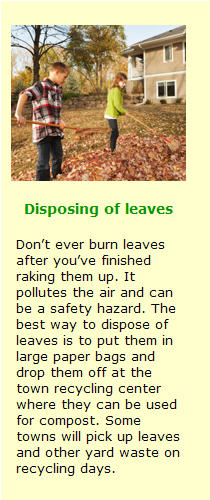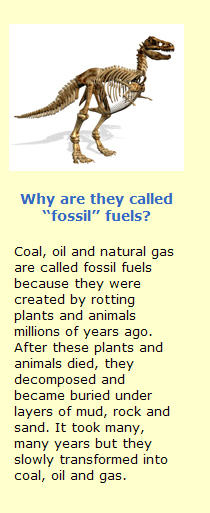 |
|||
| Fall 2012 | |||
|
|||
Underground pipelines carry natural gas to your home. This gas is used for heating, stoves, clothes dryers and hot water heaters. It’s important that these pipelines work properly because a gas leak can be a safety hazard. For this reason, National Grid workers are always testing gas pipelines and making repairs when necessary. It doesn’t happen very often but gas leaks do occur. |
|||
|
|||
The largest pipelines are marked by special signs when they cross under a street, highway, railroad or open stretch of land. But not every pipeline has a marker. It is important to know where the pipelines are so National Grid can find them and make repairs when needed. Don’t plant trees or shrubs in an area that might make it difficult to access the pipeline and do not dig, build or place anything in the path to the pipeline. Call before you dig When water freezes and melts underground, the movement of the soil can damage gas pipelines. But the most common way a gas pipeline can be damaged is by digging in an area without making sure it is safe. If you are doing a home project that requires digging or you’ve hired a builder for a digging project, make sure you call 811 at least two days before starting the work. The 811 service will tell you if there are pipelines, electric lines or other cables under your property and let you know if it is safe to dig. Signs of a gas leak
|
|||
Energy efficiency: |
|||
Thermostat settings It not only costs money to heat your home but burning oil or gas sends pollutants into the air. So if you keep the temperature in your house a little bit lower, you’ll be using less heating fuel and helping the environment. The thermostat should be set at 68 degrees or less, and you should lower it when you go to bed or are not at home. For every degree you lower the thermostat, it saves about 2 percent of your heating bill. That’s 2 cents for every dollar. It may not sound like much but when you add it up over the fall and winter, this can save a lot of money. Weatherizing Weatherizing means protecting your home against the weather. Insulation in the walls and attic space helps keep the heat in and saves energy so fall is a good time to make sure your home has enough insulation. National Grid can help arrange a free home energy assessment where the insulation can be checked to see if it’s working properly. Heat can also escape through leaky windows and doors. Inexpensive weather stripping can help seal up these leaks. Use a warm blanket If you’re cold at night, don’t turn up the thermostat or use an electric blanket. Bundle up with a warm blanket or comforter. Install CFLs Daylight hours are getting shorter so there is more need for lighting. Compact Fluorescent Light Bulbs (CFLs) are bulbs that use 75 percent less energy and last up to six times longer than regular incandescent bulbs. They are more expensive than the regular bulbs but save a lot of money in the long run. Keep doors closed If there are rooms in the house that are not being used, such as a guest room, close the door and turn off the heating vents. There’s no point in heating an unused room. |
|||
|
|||
One solution is “green” or “renewable” energy that is produced by our own natural resources. The most common renewable energy sources are wind, water and sunshine. They are called renewable because, unlike fossil fuels, they will never run out. We’ll always have wind, running water and the sun. They are also known as “green” energy sources because they create less pollution. Solar, wind and water Solar panels create a chemical reaction that turns the energy of the sun into electricity. Wind turbines and hydroelectric (flowing water) plants use moving air and water to run generators that produce electricity. These are the best known renewable energy sources. Biomass Until recently, biomass produced more renewable energy than solar and wind combined. Biomass energy is created by collecting methane gas from decaying plants and plant products. The methane can be turned into fuel for cars and trucks. Methane can also be burned in power plants to produce electricity. Landfills, where garbage is dumped, are an excellent source for methane. Farms and manufacturing plants that make wood products are other good sources for this gas. Because it recycles waste products, biomass energy is renewable energy. Helping green energy Why doesn’t everyone use renewable energy? The main reason is that it’s more expensive to produce electricity from renewable sources. With an increased focus on “green” energy, scientists and engineers are working to develop better technologies and equipment that will produce more electricity at a lower cost. National Grid’s GreenUp program supports the use of renewable energy by helping companies that produce “green” energy. Qualified Ngrid customers may voluntarily participate by paying just a few extra dollars each month in order to utilize some of this green energy. For more information about GreenUp, click here. |
|||
|
|||
You may think that conservation and recycling are fairly new ideas that have become popular in the past 10 or 15 years. Talk to your grandparents or anyone who lived through the Great Depression and World War II, and you’ll learn some things that may surprise you. In those days, there was a worldwide movement of conservation and recycling. The world was far different back then. We didn’t know much about pollution and global warming. But even back in the 1930s and ’40s, Americans demonstrated that they could conserve, recycle and change their day–to–day behavior when necessary. These ideals have carried forward to the present day. In fact, many senior citizens are very careful about spending their money and not wasting food as well as reusing clothing and household items. During the Great Depression of the 1930s, unemployment rose to 25 percent and many Americans didn’t have money to buy essential items, like food and clothing. They learned to conserve and make the most of what they had. When the U.S. entered World War II in 1941, the government started a rationing program. Rationing means only allowing people a limited amount of certain things. Each family was given a book of rationing stamps that limited the amount they could buy when purchasing food, gasoline and other items. Drivers not directly involved with the war effort were limited to four gallons of gasoline per week. So even back then, people were encouraged to use buses and trains. There was also a big recycling program. Our government encouraged people to save certain materials, like scrap paper, metals and rubber, and donate to the war effort. The paper was used for packing equipment and weapons. Metal was recycled and used to manufacture bombs. Children went door–to–door in their neighborhoods and collected these items. It not only helped the war effort but built a strong sense of community. You could say that today’s recycling movement may have actually started in the 1940s. Conserving energy wasn’t a big issue in those days because we didn’t know as much about pollution and global warming, and we didn’t use nearly as much energy. Most homes and businesses were not air conditioned and the selection of electronic devices was far less. In fact, electric refrigerators didn’t become popular until the 1940s. Before that, many people used ice to refrigerate food. Televisions weren’t widely used until the 1950s. So the demand for electricity wasn’t nearly as much as it is today. By learning what went on in the 1930s and ’40s, we can gain a greater understanding of today’s world. Talk to your grandparents, neighbors or other senior citizens and they’ll be happy to share stories of the good old days. You might even want to volunteer time at a nursing home or senior center. Our senior citizens are survivors. They lived through a depression and a world war, and there are many important lessons to be learned. The lessons you learn from speaking with a senior, and the conversation itself, will undoubtedly enrich your life. |
|||
Explore our world of energy education… |
#9220 © 2012 Culver Media, LLC |






 Fall is finally here; there’s a bit of a chill in the air and the days are getting shorter. You’ll be using more heating and lighting in your home, so let’s take a look at ways you can save energy.
Fall is finally here; there’s a bit of a chill in the air and the days are getting shorter. You’ll be using more heating and lighting in your home, so let’s take a look at ways you can save energy.
 More and more, utilities are looking for ways to produce electricity that do not involve the use of coal, oil or gas. Burning these “fossil fuels” can release harmful gases into the air, which is unhealthy for the environment.
More and more, utilities are looking for ways to produce electricity that do not involve the use of coal, oil or gas. Burning these “fossil fuels” can release harmful gases into the air, which is unhealthy for the environment.
 Families that live with, or close to, their extended family can attest to the enrichment provided by a close relationship with aunts, uncles and grandparents. In general, spending time with senior citizens can help us better understand our past and shed new light on our future. Despite the age gap, seniors can relate to adolescents in many ways—they’ve been there before.
Families that live with, or close to, their extended family can attest to the enrichment provided by a close relationship with aunts, uncles and grandparents. In general, spending time with senior citizens can help us better understand our past and shed new light on our future. Despite the age gap, seniors can relate to adolescents in many ways—they’ve been there before.